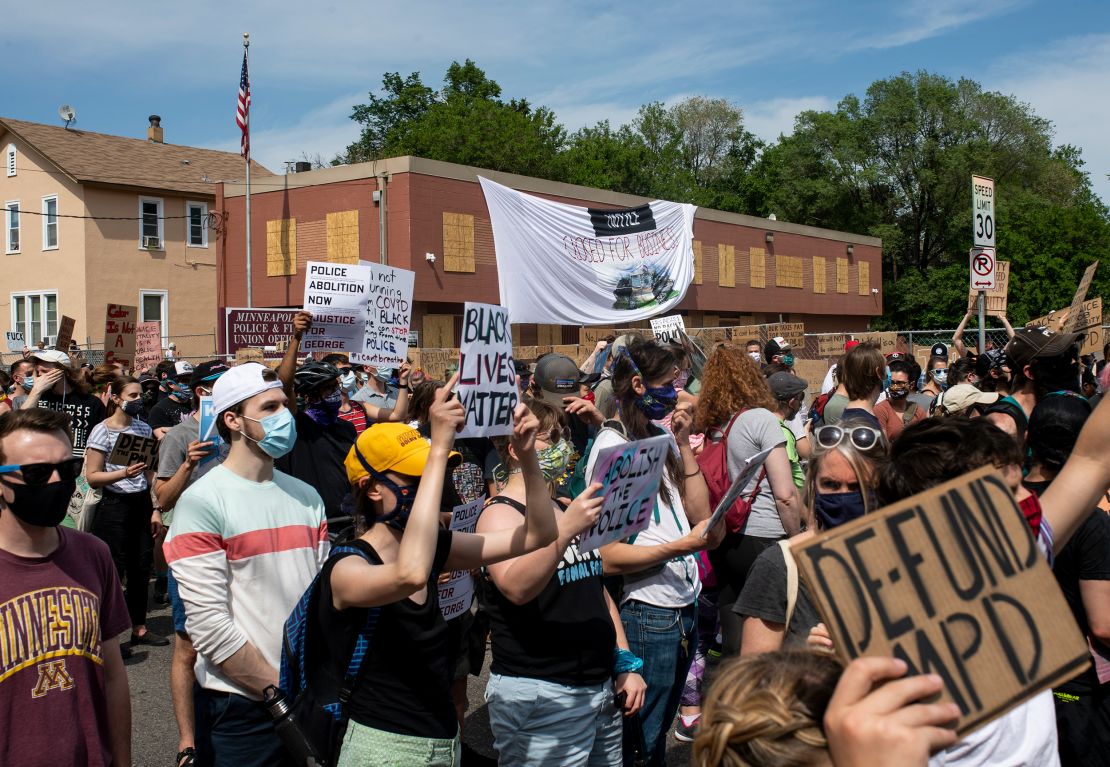The pledge to dismantle the Minneapolis Police Department made by city councilors in Powderhorn Park after the murder of George Floyd has come to represent all manner of political and media aspirations over the future of policing in America.
The nearly 18 months since Floyd’s death on Memorial Day 2020 has been marked by protests and court battles and political grandstanding by elected officials across the country. On Tuesday, voters in Minneapolis will have their first chance to weigh in on a concrete proposal to begin overhauling policing there.
Passage of the measure, requiring 51% of those voting on the question to answer “Yes,” would lead to the creation of a “Department of Public Safety.” If the city continued to employ police officers, then they would be organized under that department. It would also remove a requirement to employ a minimum number of officers and would split authority for the new department between the mayor and city council.
But from there, it’s not clear. People on both sides of the ballot measure agree that what Minneapolis has now isn’t working.
Polling by the Minneapolis Star Tribune showed 49% of voters favored replacing the police department with a department of public safety, though 55% of voters said the city should not reduce the size of its police force.
The ballot measure alone does not mean the end of policing in Minneapolis, as promised in the park; that possibility passed long ago. And the ballot measure’s passage or failure also doesn’t represent what elected leaders and national media figures have suggested: that it’s a wholesale referendum on the “defund the police” movement.
The ballot measure “is really a much more fundamental boring thing about the organizational chart,” said Barry Clegg, chairman of the commission that oversees Minneapolis’ government structure.
Change in Minneapolis, if it happens, will be incremental. Failure of the measure does not mean that all is lost for those who want to overhaul policing there.
And if it does pass there’s disagreement if, when, and how the city may begin to scale back the role of police in the city.
But the goal, according to JaNaé Bates, communications director for the “Yes” campaign, would be to have a range of non-police options for 911 calls. Proponents of the change have said that budgetary constraints created by the minimum staffing requirement, and the mayor having executive oversight, has hampered overhaul efforts.
“Having this (public safety) department makes it possible for police officers to be well disciplined, and well trained and deployed in the situations that they’re qualified and trained to do,” Bates said. “But that they will no longer have to be deployed in every single circumstance that we use 911 for.”
The uncertainty, and the shift in the way police reform advocates have talked about reform efforts, is part of what’s driving the “No” campaign.
“The rhetoric has changed from when these guys stood on stage, now they’re trying to sell this as a minor reorganization,” said Leili Fatehi, spokesperson for the “No” campaign. “Is it transformational and a major change, or nothing to worry about and a minor reorganization? Which is it? There’s no clear answers.”
Ballot language deals with structural change

Most small cities in Minnesota have authority spelled out by the state legislature. Most large cities have their structure set by voters through a commission that oversees the city’s charter, which is like a constitution.
That document can’t easily be changed, and Minneapolis’ charter requires the city to have a police department staffed by a minimum number of officers that’s tied to the city’s population. The staffing is a result of a dispute about 60 years ago; the overall government structure was set up about 100 years ago.
City Council President Lisa Bender said that if the measure passes the police department would be moved into the new Department of Public Safety, alongside smaller offices of violence prevention and traffic enforcement, and a program aimed at limiting police involvement on mental health calls. The city is widely expected to retain its officers; Clegg said they’d be represented by the same union and same contract.
“There are folks who do not want us to have police or rely on policing, but the vast majority expect and want there to be law enforcement,” Bender said. She supports the measure. “Therefore, there will be (law enforcement) in our city. That’s just how policy works.”
The police department is a “charter” department because of its place in that document, which means it can’t just be reorganized by council vote. The police department is the only department in the city that reports exclusively to the mayor, though it’s normal in big cities for all city departments (like public works, human resources, etc.) to report to mayors. The rest of Minneapolis’ departments report to a committee overseen by the mayor and city council. Clegg, who chairs the charter commission, has previously described Minneapolis’ form of government as having a “14-boss problem.”
If the ballot measure passes, the city would create a new public safety department overseen by the mayor and council and remove the requirement to employ police officers. The city would need to appoint a new public safety commissioner. The office of Mayor Jacob Frey, and the union representing rank-and-file Minneapolis police officers, didn’t respond to requests for comment.
The ballot language deals with a structural change in Minneapolis government. Implementing that change, and the daily operations of the police and other related departments, would still have to get sorted out. (Even getting the proposal on the ballot, after supporters gathered thousands of signatures, was a fight.) The ambiguity in what will follow has allowed people on both sides of the issue to muddy the public’s perception on what this may mean for the city.

‘It feels like and sounds like an experiment’
Clegg said that passing the ballot measure wouldn’t abolish the police department; it would just take away its status as a charter department. The role of policing in Minneapolis after that would be up to the city council and the mayor to work out.
The Minneapolis City Clerk told a neighborhood association that if the measure passes it would eliminate the Minneapolis Police Department from the city code. They can’t leave the police department in the city code because the code refers to the charter, which would be amended by the ballot measure.
“I know people have said, ‘Oh … if we remove the Police Department from the charter we still have the code.’ I don’t think that’s a good argument … the language of our code says literally this: There shall be a Police Department. It shall be headed by a police chief who shall report exclusively to the mayor. We just eliminated that from the charter, we can’t leave that in the code. It would be in direct conflict with voter intent,” City Clerk Casey Carl told the group.
Carl said the plan to retain officers should be to amend the code to say that any law enforcement previously done by police would be moved under the new department, pending whatever the city council decides the future of policing should look like.
But from there, the direction of the city’s approach to public safety would be left to city councilors and the mayor. Complicating matters is another question on the same ballot that would reorganize the rest of the city departments under the mayor, just like the police department is organized now. These are seemingly at odds with each other, and Clegg said that the non-conflicting parts of both would be implemented. Supporters and opponents said conflict could potentially be settled in court.
Larry Jacobs, a professor at the University of Minnesota’s school of public affairs, called the scenarios a “recipe for chaos.”
Teto Wilson, owner of Wilson’s Image Barbers and Stylists, said he was voting “no” on the ballot measure because he doesn’t see a clear plan for what happens if the measure passes. Wilson, 48, witnessed the 2015 shooting of Jamar Clark by Minneapolis police.
“It feels like and sounds like an experiment. They have not been able to flesh out from top to bottom what this Department of Public Safety is gonna look like,” he said. “You know, if you can’t tell us – and I’m not saying you have to have one hundred percent of everything, you know, fleshed out – but give us something. You know what I mean? Put some meat on the bones. There’s nothing here other than we’re gonna have a Department of Public Safety and, you know, it’s gonna have mental health workers that go on calls. That’s not enough.”
It’s not clear that passage of the policing measure would result in less spending or fewer officers in the city, though it would make it easier for the council to have that discussion by removing the minimum staffing requirement. The city also has the looming potential of a consent decree, which typically costs cities millions of dollars in policy changes and training, along with costs related to oversight and litigation.
“These changes have to move at the pace of the city, not just the pace of imagination of what we want 20 years from now,” said Bates, the “Yes” campaign spokesperson. “I’m OK with that if it means we’re moving forward.”
The campaign advocating people vote “No” insists the measure will result in defunding and eliminating the Minneapolis Police Department. The “Yes” campaign insists that’s not the case. At the very least, there’s a feeling the “Yes” campaign is avoiding the language that was so polarizing last summer.
Jacobs said, if it passes, the mayor and city council would take their direction from voters in deciding when and how to implement new policing-related policies.
“If (the ‘Yes’ campaign) said they were going to cut the police force by 200, they’re going to lose. They don’t say that. They talk about righteous and understandable rage to reign in the police department, which is out of control,” Jacobs said. “It’s pretty clear the direction is intended to be quite different, and this would be used as kind of a path. The community is very well organized. If this thing passes, it’s highly unlikely you’re going to see the mayor and city council ignore what will be a historic bill.”
Correction: A previous version of this story incorrectly spelled the last name of Barry Clegg, chairman of the commission that oversees Minneapolis' government structure.








